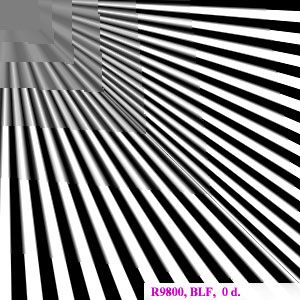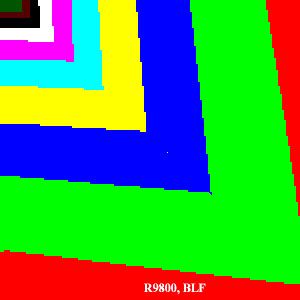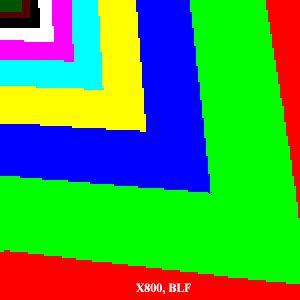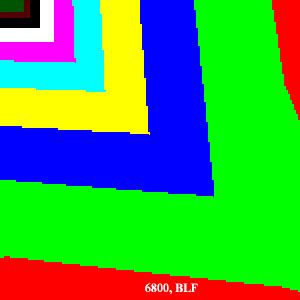 |
||
|
||
| ||
CONTENTS
Well, time flies... Announcements were made long ago, the spring is gone, but where are the new products? Timidly, as if shy of something, RADEON X800 Pro appears, but neither GeForce 6800 nor X800 XT PE are on the horizon. What is it, temporary problems or a return to older times when many weeks separated announcements and releases? Hopefully, the former. Although to be fair, we can only blame GeForce 6800 for not being sold, as there's been just about a month since the R420 announcement, and X800 Pro is being already sold in Western countries (of course, at exorbitant prices due to the absence of rivals). So, today we'll go on with current issues concerning R420 and NV40 and also examine the first serial card to appear on the Russian market, Sapphire RADEON X800 Pro.
Theoretical materials and videocard reviews concerning
Note the last material from the list above. It opened an analysis of the recent situation caused by all possible stories about filtering (including trilinear one). It is known that both ATI and NVIDIA implement various techniques to increase performance by means of optimisations of trilinear and anisotropic filterings. There was a huge scandal about partial trilinear filtering and a lot of dirty linen was washed in public. Thus, ATI officials were reminded of their statement made this April in Toronto where R420 was presented. The company's representatives then condemned any tricks with trilinear filtering and alleged that NVIDIA had been doing such things for a long time. However, it turned out later that RADEON 9600 and X800 had all sorts of optimisations too. But even ATI high-ranking executives state that optimisations and tricks are different things, and their company doesn't increase performance at the expense of quality, in contrast to their rival that allegedly uses tricks. Offended, NVIDIA made another scandal in return, which resulted in the Californian act smoking out the secret presentation. And that was really a hit below the belt for ATI. The events do not show either company in a favourable light as foul play in the PR sphere has never been approved. It's not a good idea to exchange accusations. The companies should do what they are supposed to: make products and drivers. And then, users and analysts will decide for themselves which company they like better, why ATI doesn't want to use shaders 3.0, and why NVIDIA doesn't supply 500W PSUs with their cards. Well, tricks with trilinear filtering do take place. A test in our third part revealed certain optimisations, but NVIDIA took a fairer approach (at least in drivers 60.72) making it up to users to decide whether to simplify trilinear filtering or not. ATI, in contrast, made an admission and tried to justify their actions by claiming that users wouldn't even notice anything. It was only after a strong pressure was applied that the comapny's leading CATALYST expert promised that a switch same with NVIDIA's will ve introduced into the settings panel. I personally don't consider such behaviour correct and exemplary. Trilinear filtering is one of the basic functions, it is clearly specified in API documentation. Nobody has the right to change it in any way, and those who substitute it with approximation have always been reviled (remember TNT and Voodoo in their last months). Even if developers think that it is appropriate to use a simpler algorithm that requires lower pipeline load than a full trilinear filtering, they still ought to let the user decide whether to enable this optimisation or not. It may be set by default, but then there must be a way to disable it. Well, new ATI drivers will show if our hopes have been heard. By the way, there are also claims about NVIDIA drivers 61.11 (.12) that the disabling of those optimisations is allowed but doesn't work. Although to be fair, we must say that all 6x.xx versions are yet unofficial and uncertified (in contrast to CATALYST), so it may be just that the settings panel and the driver core are temporarily incompatible. But we'll also have to think about the things these optimisations bring besides performance increase. Does the quality really fall? I mean, not in a test specially written for this, but in real games. It is a difficult but crucial question. Fragment Five of our research will help to find an answer to it. As for now, we'll go on examining filtering in synthetic tests. Only this time around, we'll take a complex and global approach and estimate anisotropy in all its forms and at different angles.
Part 1: RightMark3D-based filtering testsA brief reminder of the boards in question.
Boards
Both of them are reference cards, that is, pre-serial products. But later on, we'll deal with serial items as well. Both cards have 256-MB GDDR3 memory with a 1.6ns access time. Memory frequencies are 550 (1100) MHz in NV40 and 575 (1150) MHz in R420. Chip frequencies are 400 and 450 MHz for NV40 and 525 MHz for R420. Each GPU contains 16 pixel pipelines and 6 vertex ones. NV40 also supports shaders version 3.0, and R420 supports 3Dc, the company's proprietary technology of normal map compression.
Setup and driversConfigurations of testbeds:
D3D RightMark synthetic testsThe version of D3D RightMark Beta 4 (1050) synthetic benchmark we used, as well as its description are available at http://3d.rightmark.org To test the quality, we used a special texture ("zebra") that consists of black and white horizontal stripes. This is the best texture to identify the limit of filtering effectiveness and other features including the character of optimisation and MIP-level selection. Legend:
So, this is a special filtering quality test. |
| Bilinear filtering, 0° | ||||
|
|
|
|
|
|
|
|
 |
 |
 |
|
|
|
 |
 |
 |
|
All accelerators perform bilinear filtering in an expectedly similar way. The only differences result from slightly different formulas of MIP-level selection, depending on the distance to the display surface and the angle of the textured polygon.
Paradoxically, ATI's method is closer to the standards of computer graphics (coming back to the previous material, the BORDER=1 between MIP levels must look as a quarterfoil for the infinite tunnel). Whereas NVIDIA's method is closer to the physical meaning: calculation of the ratio between the pixel area and the area of the texture piece projected upon it. Our next article will contain a more detailed description of the algorithms and the essence of anisotropic filtering. We'll also deal with MIP-level selection and examine various approaches in terms of image quality. For now, we'll just note this difference that the above screenshots show. As for bilinear filtering, it is obviously performed in one and the same way. Well, it's no surprise, optimisations of the oldest hardware graphic accelerating operation would be too much.
Write a comment below. No registration needed!
|
Article navigation: |
| blog comments powered by Disqus |
| Most Popular Reviews | More RSS |
 |
Comparing old, cheap solutions from AMD with new, budget offerings from Intel.
February 1, 2013 · Processor Roundups |
 |
Inno3D GeForce GTX 670 iChill, Inno3D GeForce GTX 660 Ti Graphics Cards A couple of mid-range adapters with original cooling systems.
January 30, 2013 · Video cards: NVIDIA GPUs |
 |
Creative Sound Blaster X-Fi Surround 5.1 An external X-Fi solution in tests.
September 9, 2008 · Sound Cards |
 |
The first worthwhile Piledriver CPU.
September 11, 2012 · Processors: AMD |
 |
Consumed Power, Energy Consumption: Ivy Bridge vs. Sandy Bridge Trying out the new method.
September 18, 2012 · Processors: Intel |
| Latest Reviews | More RSS |
 |
Retested all graphics cards with the new drivers.
Oct 18, 2013 · 3Digests
|
 |
Added new benchmarks: BioShock Infinite and Metro: Last Light.
Sep 06, 2013 · 3Digests
|
 |
Added the test results of NVIDIA GeForce GTX 760 and AMD Radeon HD 7730.
Aug 05, 2013 · 3Digests
|
 |
Gainward GeForce GTX 650 Ti BOOST 2GB Golden Sample Graphics Card An excellent hybrid of GeForce GTX 650 Ti and GeForce GTX 660.
Jun 24, 2013 · Video cards: NVIDIA GPUs
|
 |
Added the test results of NVIDIA GeForce GTX 770/780.
Jun 03, 2013 · 3Digests
|
| Latest News | More RSS |
Platform · Video · Multimedia · Mobile · Other || About us & Privacy policy · Twitter · Facebook
Copyright © Byrds Research & Publishing, Ltd., 1997–2011. All rights reserved.